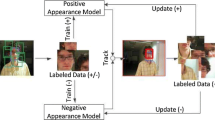Abstract
Robust, accurate and efficient pedestrian tracking is a critical task in intelligent visual surveillance systems and robotic vision applications. Unfortunately, tracking in realistic scenarios is not easy and may fail due to the challenges of partial occlusion, viewpoint changes and cluttered background. To overcome these challenges, different tracking strategies have been proposed to model the tracking process as a first-order temporal Markov chain. It has been well-known that target appearance modeling approaches play essential function in this process, but most these approaches only represent the object characteristics in the pixel/texture level instead of investigating the latent information in the semantic understanding level. Therefore, the obtained optimum state based on the texture similarity may not be as same as observed by human vision system. To resolve this limitation, in this paper, we proposed a multiple pedestrian tracking algorithm based on couple-states analysis, the hidden state is used to obtain the estimated observations during the Markov chain transition process, and the latent state is used to find the semantic information about each observation. By maximizing the likelihood probability of the couple states for each estimation, the optimum state of target can be found more accurately, and error accumulation can also be effectively decreased during tracking. The performance of the proposed tracking has been verified on different benchmark surveillance video database, the results showed that the proposed tracking is able to track multiple pedestrians more accurately in variety of challenge scenarios when compared with other state-of-art multiple pedestrian tracking approaches.











Similar content being viewed by others
References
Arulampalam MS, Maskell S, Gordon N, Clapp T (2002) A tutorial on particle filters for online nonlinear/non-Gaussian Bayesian tracking. IEEE Trans Signal Process (TSP) 50:174–188
Avidan S (2007) Ensemble tracking. IEEE Trans Patt Anal Mach Intell (T-PAMI) 29:261–271
Babenko B, Yang M-H, Belongie S (2009) Visual tracking with online multiple instance learning, In: IEEE conference on computer vision and pattern recognition (CVPR)
Black MJ, Jepson AD (1998) Eigentracking: robust matching and tracking of articulated objects using a view-based representation. Intern J Comput Vis (IJCV) 26:63–84
Collins RT (2003) Mean-shift blob tracking through scale space, In: IEEE conference on computer vision and pattern recognition (CVPR)
Comaniciu D, Ramesh V, Meer P (2003) Kernel-based object tracking. IEEE Trans Patt Anal Mach Intell 25:564–577
Dalal N, Triggs B (2005) Histograms of oriented gradients for human detection, In: IEEE conference on computer vision and pattern recognition (CVPR)
Dinh TB, Vo N, Medioni G (2011) Context tracker: exploring supporters and distracters in unconstrained environments, In: IEEE conference on computer vision and pattern recognition (CVPR)
Grabner H, Leistner C, Bischof H (2008) Semi-supervised on-line boosting for robust tracking, In: European conference on computer vision, ECCV
Hare S, Saffari A, Torr PHS (2011) Struck: structured output tracking with kernels, In: IEEE international conference on computer vision (ICCV)
Henriques F, Caseiro R, Martins P, Batista J (2012) Exploiting the circulant structure of tracking-by-detection with kernels, In: European conference on computer vision (ECCV)
Hofmann T (1999) Probabilistic latent semantic indexing, In: International ACM SIGIR conference on research and development in information retrieval, SIGIR
Jepson AD, Fleet DJ, El-Maraghi TF (2003) Robust online appearance models for visual tracking. IEEE Trans Patt Anal Mach Intell (T-PAMI) 25:1296–1311
Kalal Z, Mikolajczyk K, Matas J (2010) Tracking-learning-detection. IEEE Trans Patt Anal Mach Intell (T-PAMI) 6(1):1409–1422
Kwon J, Lee KM (2010) Visual tracking decomposition, In: IEEE conference on computer vision and pattern recognition (CVPR)
Kwon J, Lee KM (2011) Tracking by sampling trackers, In: IEEE international conference on computer vision (ICCV)
Li X, Hu WM, Zhang ZF, Zhang XQ, Luo G (2007) Robust visual tracking based on incremental tensor subspace learning, In: IEEE international conference on computer vision (ICCV)
Li X, Hu WM, Zhang ZF, Zhang XQ, Zhu ML, Cheng J (2008) Visual tracking via incremental log-Euclidean Riemannian subspace learning, In: IEEE conference on computer vision and pattern recognition (CVPR)
Lindeberg T (1998) Feature detection with automatic scale selection. Intern J Comput Vis (IJCV) 30:79–116
Liu B, Huang J, Yang L, Kulikowsk C (2011) Robust tracking using local sparse appearance model and \(K\)-selection, In: IEEE conference on computer vision and pattern recognition (CVPR)
Niebles JC, Wang HC, Li FF (2008) Unsupervised learning of human action categories using spatial–temporal words. Intern J Comput Vis 79:299–318
Oron S, Bar-Hillel A, Levi D, Avidan S (2012) Locally orderless tracking, In: IEEE conference on computer vision and pattern recognition (CVPR)
Ross DA, Lim J, Lin RS, Yang MH (2008) Incremental learning for robust visual tracking. Intern J Comput Vis (IJCV) 77:125– 141
Roweis S (1998) EM algorithms for PCA and SPCA, In: Advances in neural information processing systems (NIPS)
Sevilla-Lara L, Learned-Miller E (2012) Distribution fields for tracking, In: IEEE conference on computer vision and pattern recognition (CVPR)
Viola P, Jones MJ (2004) Robust real-time face detection. Intern J Comput Vis (IJCV) 57:137–154
Wu Y, Lim J, Yang MH (2013) Online object tracking: a benchmark, In: IEEE conference on computer vision and pattern recognition (CVPR)
Yao R, Shi Q, Shen C, Zhang Y, Hengel A (2013) Part-based visual tracking with online latent structural learning, In: IEEE conference on computer vision and pattern recognition (CVPR)
Yilmaz A, Javed O, Shah M (2006) Object tracking: a survey. ACM Comput Surv 38:13–58
Zhang K, Zhang L, Yang M (2012) Real-time compressive tracking, In: European conference on computer vision, ECCV
Acknowledgments
This research is supported by Research Fund for the Doctoral Program of Higher Education of China (No.2012610,2120055), National Natural Science Foundation of China (No.61301194 & No.61175018 & No.61363046) and a grant from NWPU (3102014JSJ0014) and Fok Ying Tung Education Foundation (131059) as well as 20142BBE50023, 20142BAB217033 and 20142BAB217030 approved by Jiangxi Provincial Department of Science and Technology.
Author information
Authors and Affiliations
Corresponding authors
Additional information
Communicated by L. Xie.
Rights and permissions
About this article
Cite this article
Zhang, P., Wang, L., Huang, W. et al. Multiple pedestrian tracking based on couple-states Markov chain with semantic topic learning for video surveillance. Soft Comput 19, 85–97 (2015). https://doi.org/10.1007/s00500-014-1375-9
Published:
Issue Date:
DOI: https://doi.org/10.1007/s00500-014-1375-9




